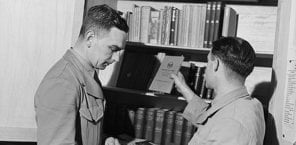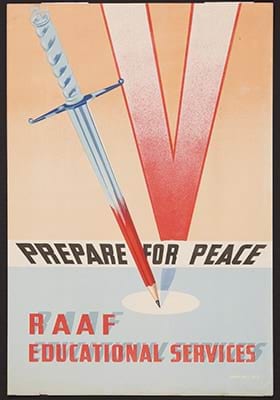
- Conflict:
- Second World War (1939-45)
- Service:
- Air Force
RAAF Educational Services was established in 1941 to meet this need through the provision of vocational training and, like that of Australian Army Education Services (AAES), was doubly conceived to play a larger role in ‘re-establishing the returning soldier into a changed society by providing a full range of educational activities at all levels and encouraging discussion of social, political and economic issues.’
Courses for service men and women—focussed on agriculture, art, building trades, commerce, electrical trades, printing, public health, mechanical trades, women’s crafts, and general education—were provided free of charge with a 15-shilling deposit refunded on completion. In addition, the service provided a circulating library comprised of easily transportable crates containing a selection of fifty ‘good’ books for units in Northern Australia and New Guinea, radio broadcasts, a weekly journal and books and resources for discussion groups, voluntarily convened by service men and women interested in discussing topical issues.
Discussion group topics included: interior decoration for Australian homes, our pacific neighbours, what democracy means, immigration and Australia’s population problem, the Jewish people, soil erosion, party politics and the housing problem, in addition to short plays by Anton Chekhov and George Bernard Shaw. Information guides provided to discussion group leaders stated:
Your part in the most extensive experiment in adult education ever attempted in Australia is a most important one. In the difficult days ahead, we will need clarity of vision, logical thought and honest assessment of values as we never needed them before.
Praising the initiative, in 1942, Melbourne Herald correspondent Clive Turnbull wrote that:
…today you may find the members of study groups in gun pits. In paddocks, among the barbed wire on beaches… It is teaching the Australians who matter most—that is the Australians who are fighting for Australia—how to think and how to learn. It is teaching them what the war is about, and what the world is about.
The education services were not, however, without their detractors. Some felt that educational programs would divert time and resources away from more practical training, while others feared the schemes could be used to ferment socialist ideas and sympathies. To counter these criticisms supporters argued that the effort to educate defence personnel and foster within them a well-read and critical frame of mind was as vital an action in defence of democracy as combat operations against book burning fascists. Whatever their actual legacy, there is little doubt that the education services played a key role in defeating boredom, a threat to troop morale as great as that posed by any other enemy.
Author:
Toby Miller is Collections Coordinator at the Shrine of Remembrance
Updated

